 Weed Grow Guide by Royal Queen Seeds
Weed Grow Guide by Royal Queen Seeds
- Growing weed step by step
- Marijuana growing basics
- Choosing your seeds
- How to germinate seeds
- The marijuana vegetative stage
- The marijuana flowering stage
- Harvesting marijuana
- Trimming, drying, and curing
- Choosing pots and soil
-
Growing indoors
- A Complete Overview Of Growing Cannabis Indoors
- Cannabis Cultivation Tips: How To Set Up Indoor Grow Lights
- How Many Cannabis Plants Can You Grow Per Square Metre?
- Indoor Cannabis Growing: Relative Humidity and Temperatures
- Hydroponics Cannabis Growing Guide (with diagrams)
- Cannabis Micro Growing: Growing Great Weed in Tiny Spaces
- Growing outdoors
- How to grow autoflowering marijuana
- Marijuana nutrients and pH
- Marijuana troubleshooting: Nutrients
-
Marijuana troubleshooting: Growing
- Cannabis Seed Germination — Troubleshooting Guide
- How to Deal With Pythium (Root Rot) in Cannabis Plants
- Slow Cannabis Plant Growth And What You Can Do About It
- How to Deal With Leggy Cannabis Seedlings
- Watering Your Cannabis: How to Fix Overwatering and Underwatering
- Understanding Male, Female, And Hermaphrodite Cannabis
- Identifying and Treating Common Cannabis Ailments
- How To Revive a Sick Cannabis Plant
- How to Avoid Moldy Marijuana During Drying and Curing
- How to Prevent and Treat Dry and Crispy Cannabis Leaves
- What Cannabis Leaves Can Tell You
- Causes and Solutions for Yellow Cannabis Leaves
-
Marijuana Strains Grow Report
- HulkBerry Automatic Grow Report
- Blue Cheese Auto Grow Report
- Purple Punch Automatic Strain Grow Report
- Triple G Automatic Grow Report
- Do-Si-Dos Automatic Grow Report
- Green Gelato Automatic Grow Report
- Haze Berry Automatic Grow Report
- Purple Queen Automatic Grow Report
- Cookies Gelato Automatic Grow Report
- Sherbet Queen Automatic Grow Report
- Sweet Skunk Automatic Grow Report
- Medusa F1 Grow Report
- Marijuana plant training
-
Marijuana growing tips
- The Cannabis Plant Anatomy
- How to preserve seeds - RQS USA
- How Much Sunlight Do Outdoor Cannabis Plants Need To Grow?
- How to Control and Prevent Stretching in Cannabis Plants
- My Cannabis Plants Are Growing Too Tall: What Should I Do?
- Should You Worry About Purple Or Red Cannabis Stems?
- What To Do When Your Indoor Cannabis Won’t Flower
- How To Protect Your Cannabis Plants From Heat Stress
- How To Tell If Your Female Cannabis Plant Has Been Pollinated
- Growing Medical Marijuana
- Bud Washing: How to Clean Your Weed
- Understanding Cannabis Yield per Plant
The stages of growing weed
An overview of the 5 stages of cannabis cultivation.
Growing cannabis comes with a lot of uncertainties. That said, cannabis cultivation itself can be broken down into five distinct stages, regardless of which seeds you’ve selected.
Getting Started
Before you just start throwing seeds into soil, consider what kind of grower you want to be. Are you running an indoor operation, or working in the great outdoors? Do you have the supplies fit for your growing environment? Have you made sure to pick seeds that'll thrive where you're planting them, indoors or out? Speaking on that last point, any aspiring grower should know the difference between photoperiod and autoflowering cannabis plants. There are a few key differences to note.
Photoperiod Plants
The main marker of a photoperiod plant is the potential for indefinite vegetation—as long as you keep the plants on an 18/6–24/0 light/dark cycle. We'll talk more about that later, but it means these plants can withstand more mistakes in the growing process. It also means you can ensure your plant produces the best crop possible once you initiate flowering. All you need to do to make the switch is adjust the light cycle to 12/12. This becomes even more useful when you're able to make unlimited clones of your optimised plant. The main drawback is that it'll take longer to be ready for harvest compared to autoflowering plants. However, you'll have a larger yield and usually more potent plant once you're there.
Autoflowering Plants
The way these differ from photoperiod plants is written in the name. Regardless of whether you feel the plant is ready, it'll start flowering at a certain time depending on the strain's genetic programming. In one sense, these plants are easier for novice growers because there's less to think about in regards to light coverage and cycle adjustment. On the other hand, due to the limited vegetation time, you have fewer opportunities for mistakes. This isn't ideal for first-timers, but the fact that it only takes two and a half months from germination to harvest is definitely appealing. Autos tend to produce lower, milder yields than their photoperiod counterparts, but modern advances are bridging the gap.
5 Stages Of Cannabis Cultivation
Now that you’re familiar with the distinctions between photoperiod and autoflowering strains, we can begin to break down each stage involved in cannabis cultivation.
Stage 1: Germination — 1–7 Days
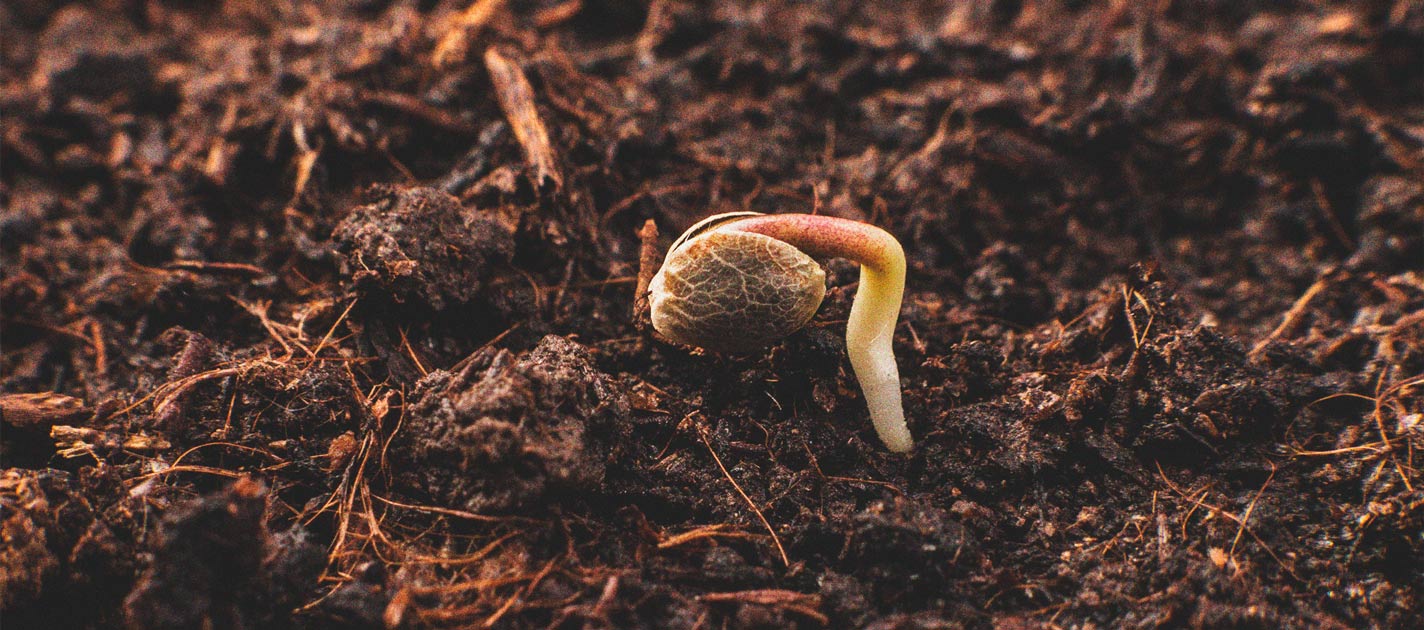
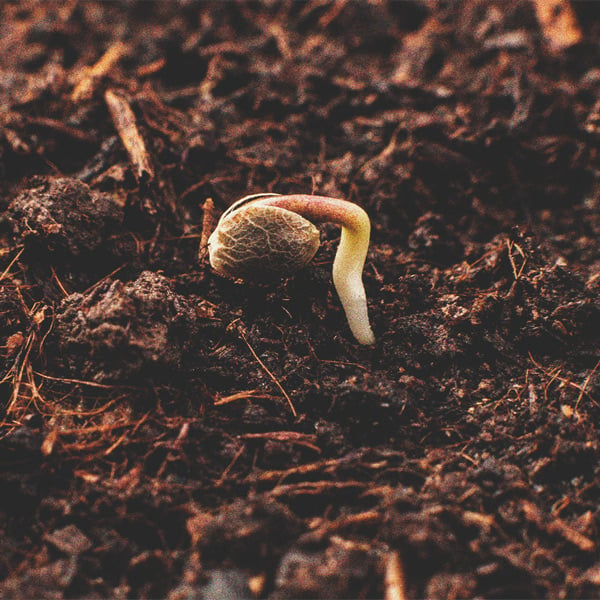
Even when your plant is a mere seed, the work you put in will dictate its success or failure. Germination is the stage when the first root cracks out of the seed's shell, which takes between 1–7 days. The wet paper towel method is a classic approach here, but you start out with the major setback of tiny fibres all over your new root. You can plant directly in the soil, of course, but you need to ensure temperature and moisture are dialled in.
If you want to keep all your seeds safe and clean, we recommend the Royal Queen Seeds Starter Kit. With that, they can enjoy clean, undisturbed germination. Once they get to 2–3cm high, you can remove them from the starter and place them in a suitable growing container.
Stage 2: Seedling — 2 Weeks
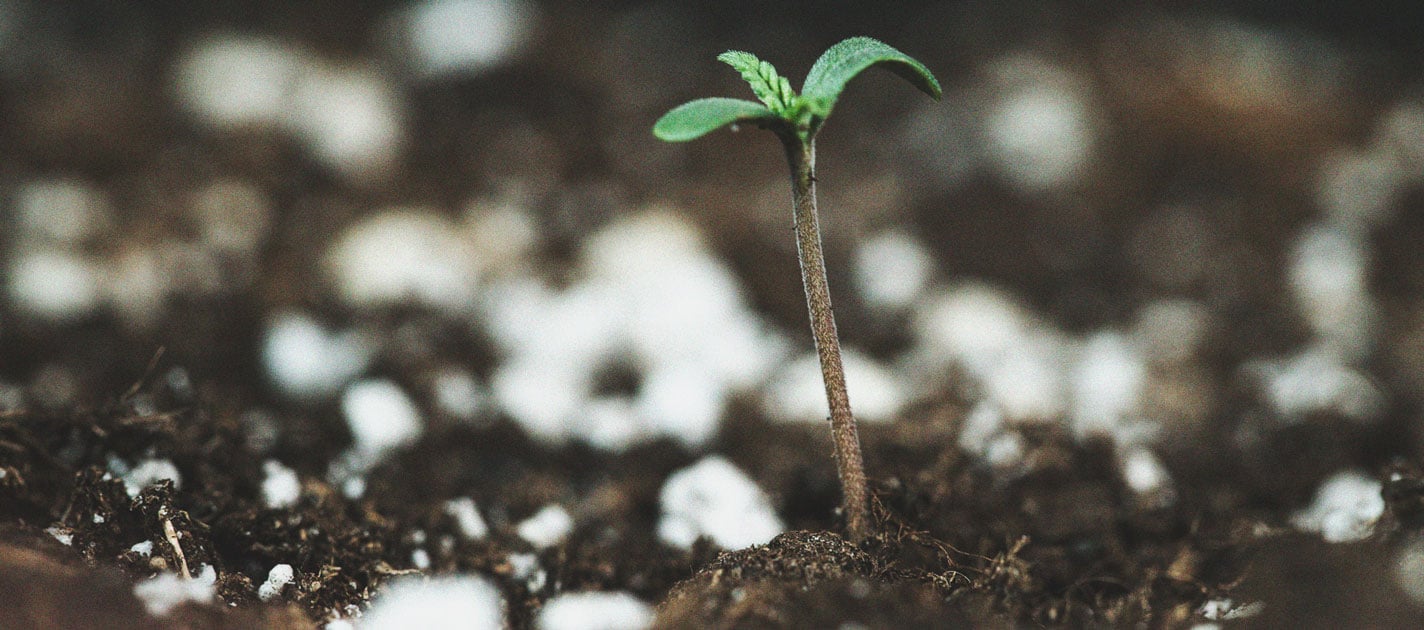
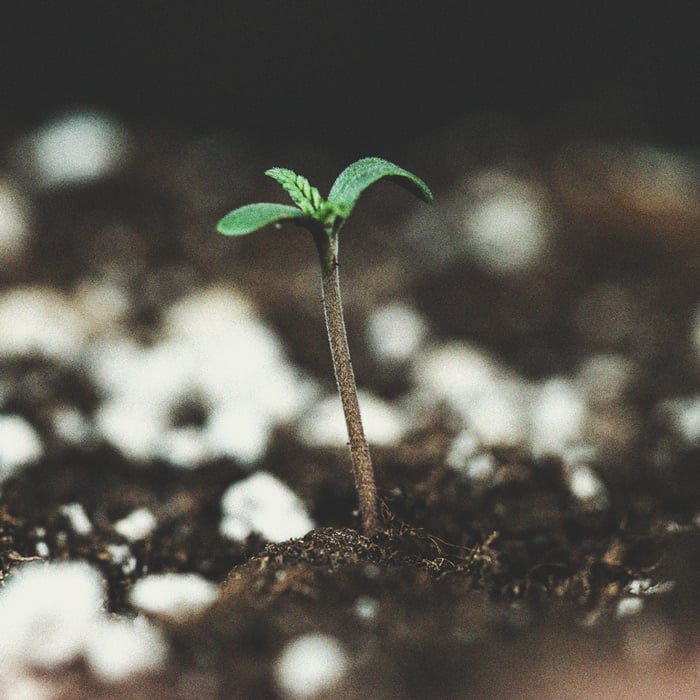
Breaking through the germination stage, plants enter the seedling stage next. At this point, they'll need about 18 or more hours of daily light. After two or so weeks of proper care, though, they'll be well on their way to robust growth.
This is the point where it starts to look more like a cannabis plant. There will be one ridged blade per leaf at first, but the blades will get closer to their typical 5–7-finger stage by the end of this period. Until they get the true leaves, though, the plants are considered seedlings.Along with the increasing blade count, a vibrant green color is another mark of a healthy plant. To keep them healthy, the two main things to keep an eye on are water and cleanliness. Seedlings are still fragile, so only light watering is necessary. Cleanliness is equally vital due to their disease and mold vulnerability. The perfect home for cannabis seedlings is a propagator, ideally with 70% RH and temps 20-25°C, under either white CFL lights or LED’s.
Stage 3: Vegetative Phase — 2 Weeks to Infinity
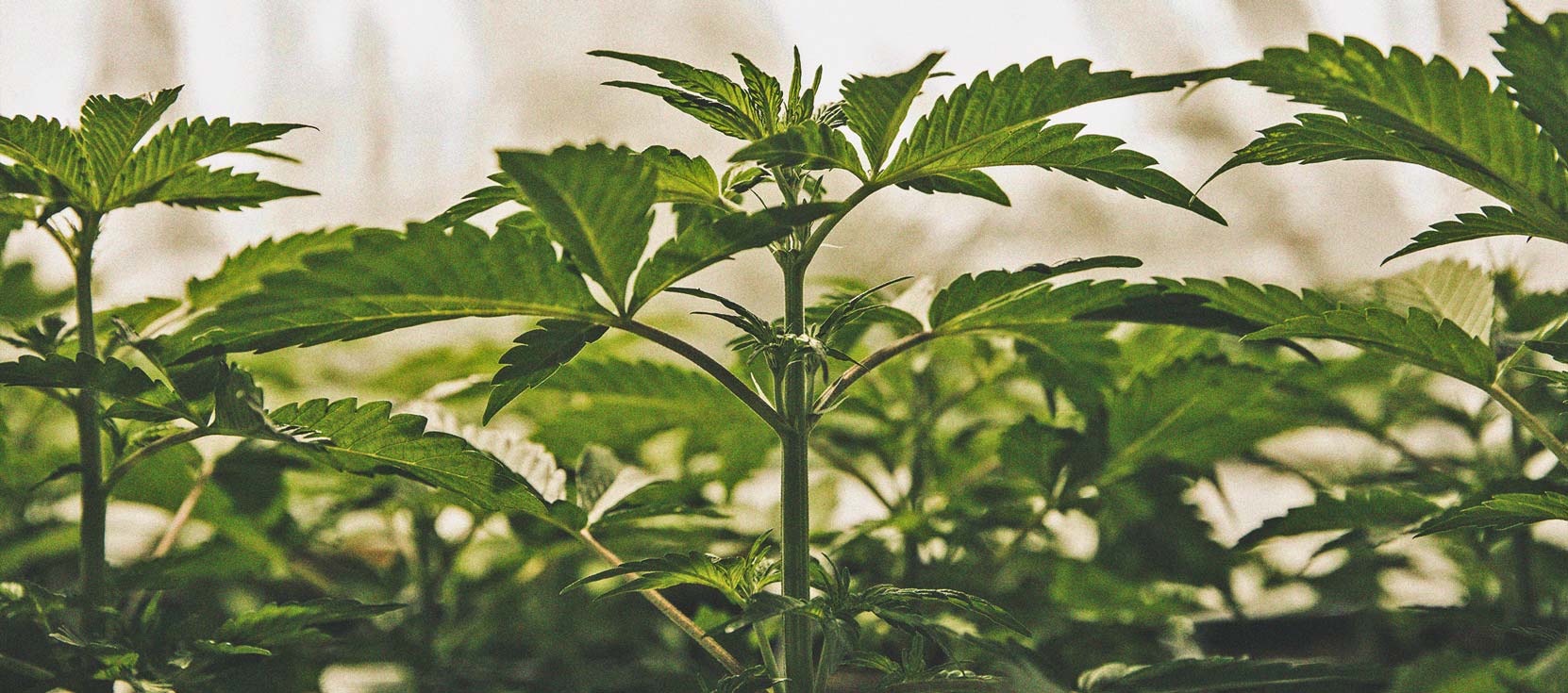
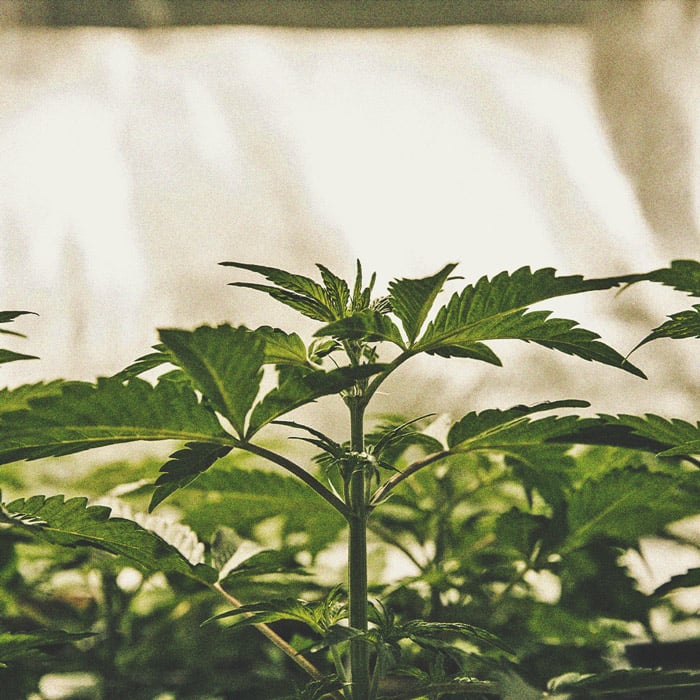
Vegetative growth is normally associated with a transplant at some point as plants outgrow the starter medium be it a Rockwool block or paper cup filled with soil or coco. Continued development of the root zone and robust branching are the top priorities for the grower. The optimal environment for vegetative growth is a RH of 50–75% and a temperature range of 20–28ºC, under either LED or metal halide (MH) lighting.
Autoflower cultivators have even less time to play with than photoperiod growers as most autos will race into flowering after just 2-3 weeks of vegetative growth. It’s for this reason that many auto growers plant their autoflowering seeds directly into the final container. The clock is ticking with autos from the moment of germination.
Photoperiod strains can be kept in vegetative growth indefinitely so long as 18+ hours of light and suitable conditions prevail. This is what allows indoor growers to keep mother plants for years and why outdoor grower’s plantin springtime. Indoors or outdoors 18+ hours of light facilitates taking cuttings too.
This is the stage to pot up photoperiod plants into final containers, at least a couple weeks before switching to bloom or prior to summer outdoors.
Free RQS
Grow Guide!
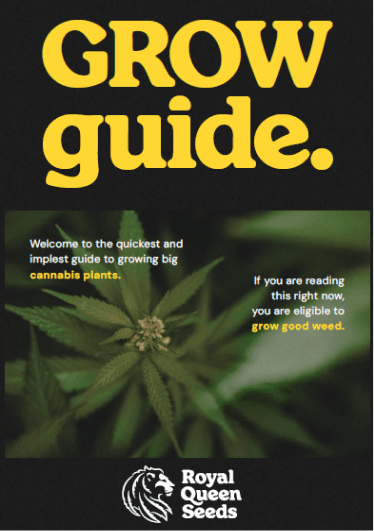
While the photoperiod strains can be kept in veg weeks or even months to allow for all kinds of pruning and training to boost yield like topping, FIM, LST or even a ScrOG the Auto grower is somewhat limited by time.
Stage 4: Flowering — 6–12 Weeks
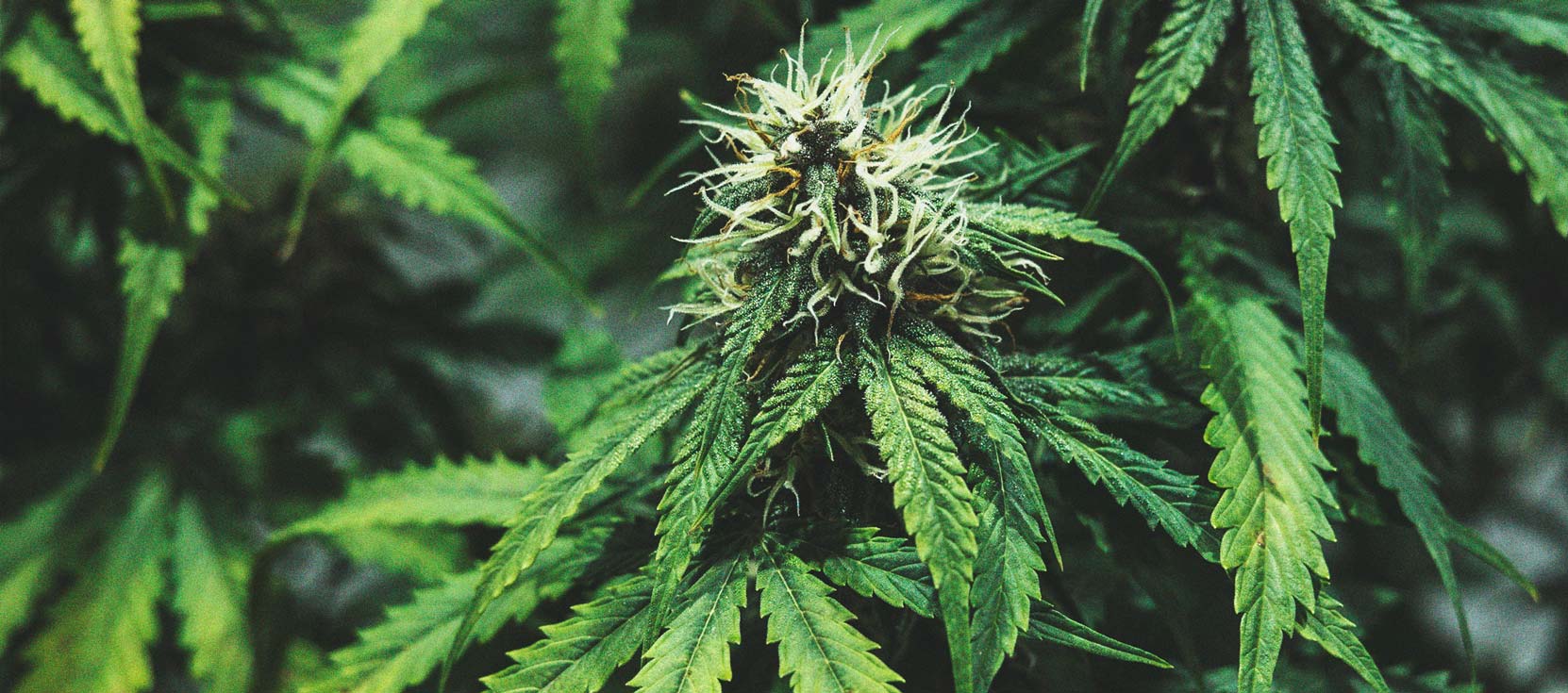
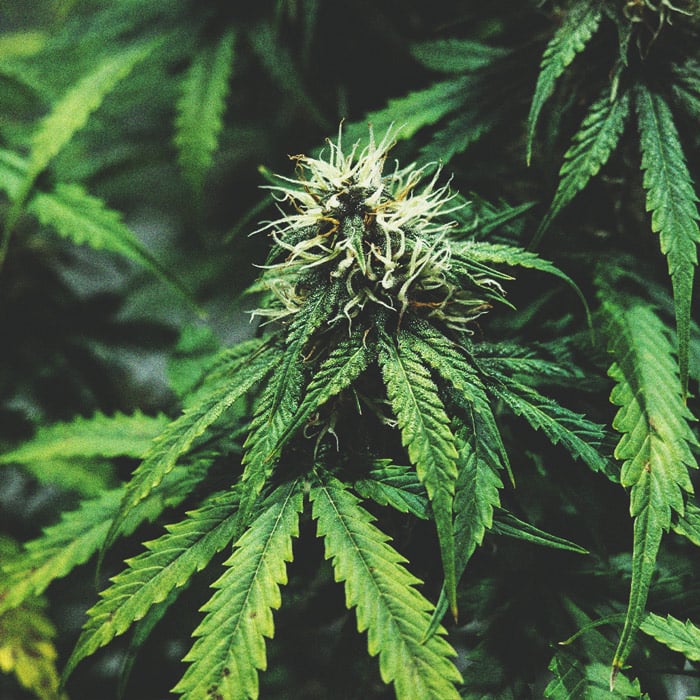
At this stage, the focus of the grower and plants switches to the production of buds and the grower is already dreaming of a frosty marijuana harvest in the near future. RH needs to be reduced to 40-50% and temps kept between 18-26°C.
Cannabis plants will first give you an indication of their sex in the early phase of bloom. Typically within the first two weeks of flowering females will develop pistils or “hairs” to confirm their femininity.
If you see “nanners” or anything resembling a cluster of grapes protruding from flowers or anywhere on the stem then you have a male cannabis plant. Should you see both hairs and nanners then you have a hermie to remove right away.
Photoperiod strains are induced to bloom by the hours of light they receive; indoors the grower changes to a 12-12 light-dark cycle to artificially promote flower growth.
Outdoors Mother Nature dictates the grower’s schedule and flowering will only commence in Summer/Fall as the hours of daylight naturally diminish, making for a longer more gradual flowering period. Weed growers in the Northern hemisphere don’t refer to October as “Croptober” for nothing.
Fastest Flowering Strains

Fastest Flowering Strains

Of course autoflowering strains don’t follow the rules due to their ruderalis ancestry, so they will begin to bloom in about a month post-germination. Auto’s prefer to stay in 18+ hours of light for flowering and will be more productive on a light-dark cycle that would inhibit photoperiod strains from blooming at all.
Flowering generally lasts 7-10 weeks for indica and hybrid photoperiod cannabis strains, while the more Sativa dominant strains can take 10-14 weeks to fully ripen into primo head stash.
Autos really only flower for 35-55 days with a much more sudden transition into flowering, choosing feminised autos is a wise choice for novices that don’t want a seeded stash.
It’s always best to evaluate if a cannabis plant is ready to harvest by taking a closer look at those resin dripping buds. Using an inexpensive scope to zoom in on those resin heads to make sure they are milky and amber rather than clear removes all the guess work.
Once you confirm you’ve got a ripe marijuana crop on your hands it’s time to break out the trimming scissors and get harvesting. After two weeks slow drying in paper bags or hung up, at room temp and approximately 50% RH, you’ve got a stash.
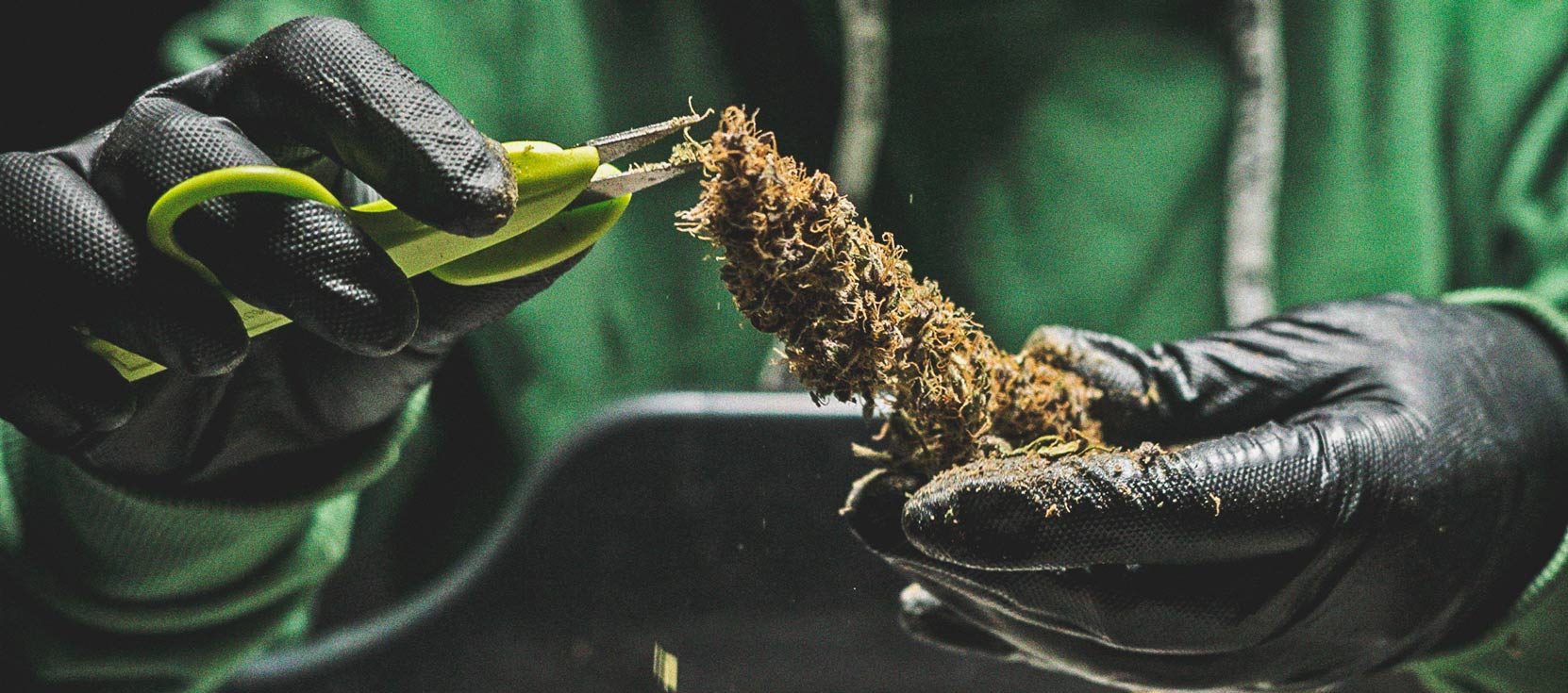
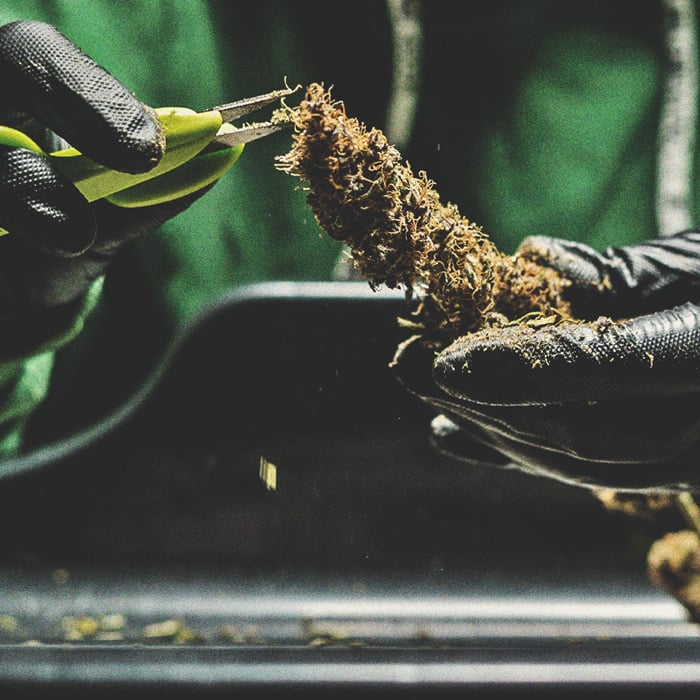
Stage 5: Harvest, Trimming, Drying And Curing — 1–2 Months
Harvesting
Harvesting is the most rewarding part of the cultivation process for many growers. Watching your plants grow over several months is mesmerising, but finally harvesting the fruits of your labor truly is the peak of the experience. The flowering phase of the grow cycle typically lasts between 6–12 weeks, after which it's time to strip your plants down of their buds. However, you don’t want to do this too early and prevent your flowers from fully maturing. Likewise, you don’t want to wait too long. Timing harvest is a crucial step, and there are multiple signs you should look out for to know when the time is right.
One of the best ways to truly tell if your flowers are ready for harvest is by getting up close and personal with a magnifying device. This visual advantage will enable you to detect minor changes that wouldn't be noticeable to the naked eye. Some growers choose to use a jeweler's loupe, which is essentially a pocket-sized magnifying glass encased in a piece of metal. Others choose to use devices such as digital microscopes, which provide greater detail.
Ultimately, the most important use for your magnifying glass is to detect the progress of your trichomes, and therefore, the proper time to harvest your buds. Trichomes are small mushroom-shaped glands that produce resin which contains the vast majority of cannabinoids and terpenes.
Looking for shifts in trichome appearance is the most accurate way to determine the stage of maturity of your crop. Trichomes are hard to miss and appear as a white frosty substance that covers the buds and sugar leaves. Zooming in on these structures will allow you to know how far along your plants are, and whether they are ready for the chop.
Earlier on in the flowering phase, trichomes will appear translucent, meaning they are immature and still developing and should be left to mature. When approximately 60% of the trichomes develop a milky look, they are ready to harvest. It's at this stage where they will produce the most significant high. However, some growers wait until up to 90% of trichomes move past this milky look and become amber, as this will cause the buds to develop a more stoning and sedating effect.
Another sign that your buds are maturing is when the pistils of the flowers change color. Pistils are small-hair like structures that grow out of the calyxes, and are the reproductive organs of the female cannabis plant. They are the site where pollination occurs—if male pollen were allowed to land there. Pistils appear bright white during the early stage of the grow cycle, and eventually shift to an orange-brown color.
Aside from the buds themselves, another way you can tell your plant is approaching harvest is by examining the color of the leaves. Provided you haven’t overfed your plants during the final stage of flowering, a yellowing of the leaves will signal that your plant is reaching peak maturity, and that its nutrients are being fully utilised by the buds. By flushing out nutrient salt buildup with pH-balanced water for a couple weeks before harvest, a smoother, more pleasant smoke is guaranteed from each plant.
Now that you know when to start harvesting your buds, it’s time to learn how to trim them.
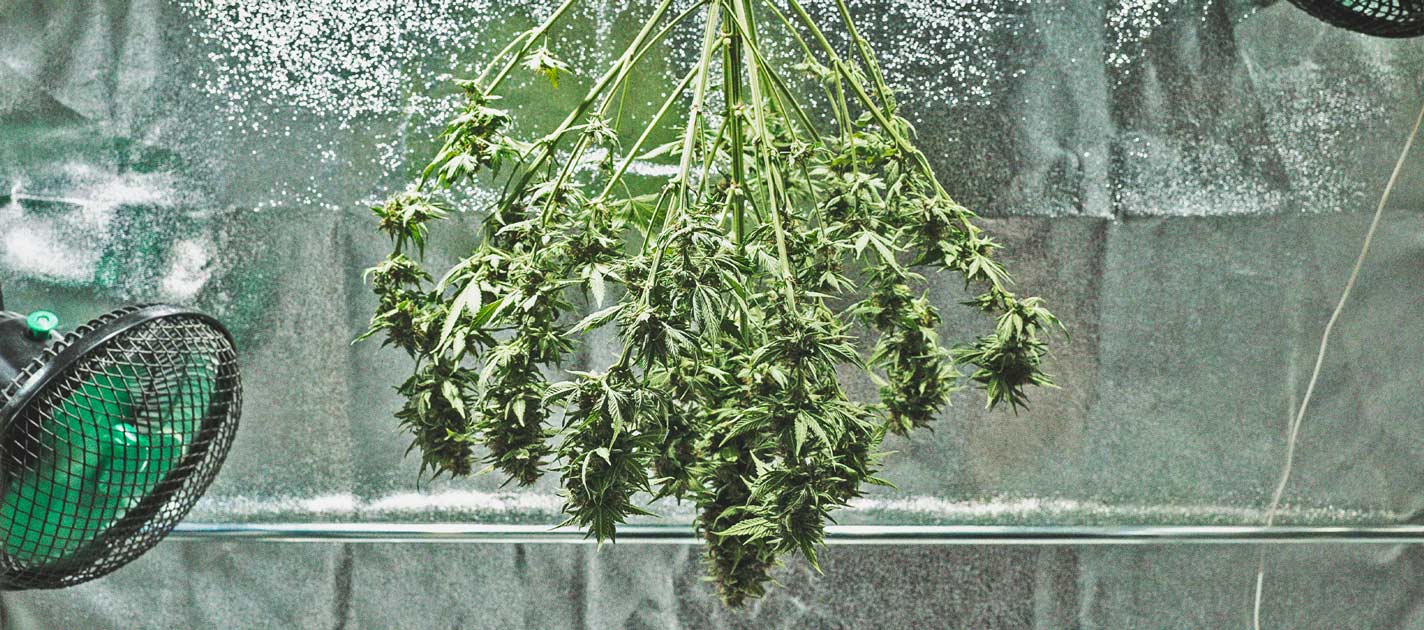
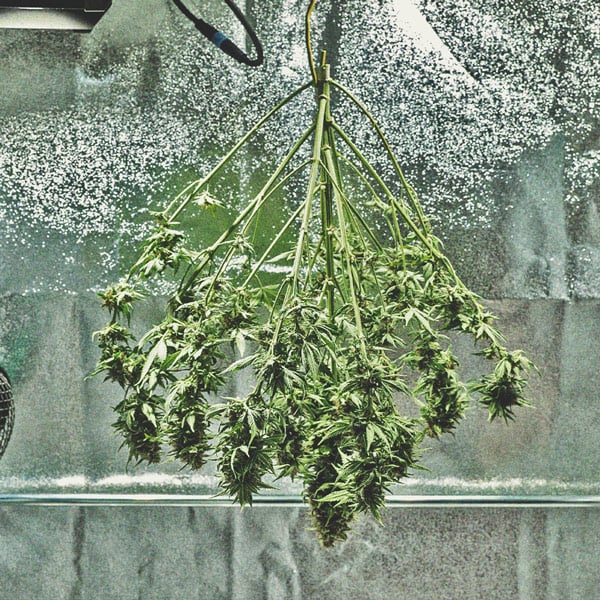
Wet Trimming
You can trim your cannabis plants in one of two ways: wet or dry. Both have their own advantages, and each grower will differ in which one they prefer. Wet trimming refers to trimming off the sugar leaves surrounding the buds immediately after harvest while the plant still has a high water content and feels “wet”. This method is the most common, and arguably the easiest, as it doesn't require a large room to dry out plants beforehand. However, wet trimming is literally sticky business. The resin from the flowers will cover both your hands and your scissors, but there is an upside to this. By scraping the resin from your scissors every now and then, you’ll quickly build up a supply of “scissor hash”, allowing you an early taste of your harvest.
Dry Trimming
Dry trimming takes place after your entire stash has been dried, and little water content remains within the buds and leaves. Trimming dry buds is definitely easier on your scissors since they won’t become as inundated by clumps of resin. However, accurately manicuring dry buds can be somewhat of a hassle too, making for a potentially less visually appealing final product. Moreover, dry trimming does require a fair bit of space. Growers usually hang entire branches of buds from a line of string within temperature-controlled rooms to let them air-out until sufficiently dry.
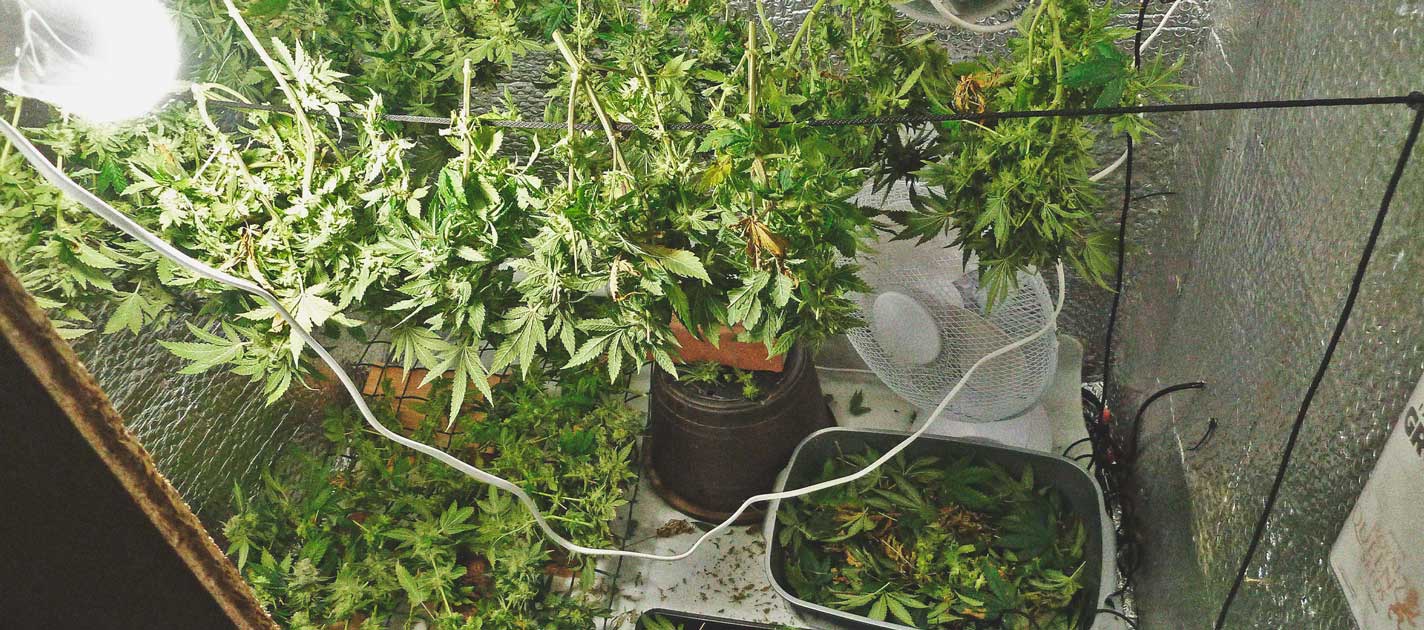
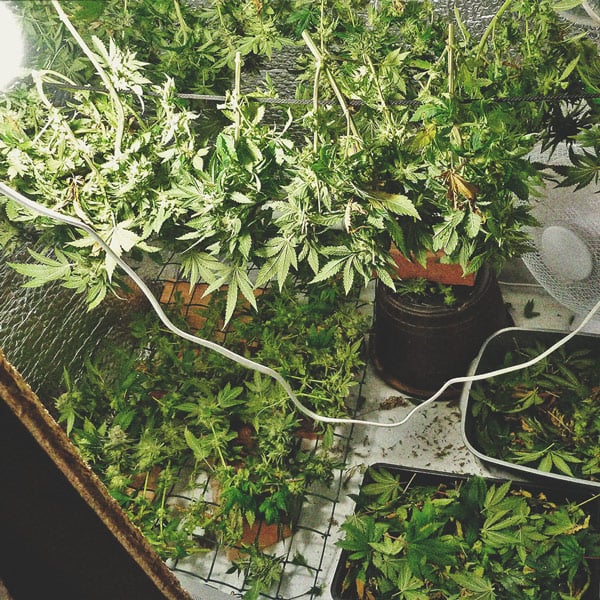
Curing Your Buds
Now that harvesting and trimming are complete, it’s time to cure your flowers. Curing is an essential process that removes the last of the residual water from the buds, minimising the chance of mold and greatly prolonging shelf life. Curing also enhances the taste and quality of the smoke, making for a smooth and potent experience.
If you opted to use the dry trimming method, then your flowers will be ready to cure straight away. If you chose wet trimming, then your flowers will need to be properly dried before you go on to cure them.
- To do this, spread them out over some cardboard, newspaper, or, even better, a wire drying rack. Whichever you choose, make sure they are spread out over a large surface area and exposed to as much fresh air as possible. Aim for a steady room temperature of 21°C and a relative humidity of 50% to ensure a longer but gentle drying process to maintain as much flavor as possible.
- Now we can move on to curing. For this, you’ll need airtight glass jars to minimise mold from taking hold. Fill each jar so it’s ⅔ full, leaving adequate room for air. This is the perfect environment for excess sugars and chlorophyll to be broken down, a process which is key for those smoother hits of smoke.
- For the first two weeks of curing, open each jar once or twice per day and remove each bud, checking for any signs of cobweb-like mold. If you detect anything, remove this bud from the jar and place it in the bin. Opening jars this regularly will also serve to replace the air within the jar, keeping it fresh.
- After a few weeks, the need to check your buds as much will reduce; the drier they become, the less chance there is of mold striking. At this stage, you’ll only need to check around twice per week to expose your buds to fresh air. After a few weeks, your buds will be cured; however, some growers choose to go a few weeks further to develop pristine and high-quality flavor. You can smoke-test you buds as the weeks go by to see if the current taste suits your preference.
For more info on drying and curing your herb, check our blogs Top Tips To Successfully Dry And Cure Your Fresh Cannabis Buds and How to Cure Your Cannabis Buds.

Royal Queen Seeds produces some of europe’s best cannabis seeds, ensuring hobby growers everywhere have access to the finest marijuana strains around.
Buy at RQS
Royal Queen Seeds produces some of europe’s best cannabis seeds, ensuring hobby growers everywhere have access to the finest marijuana strains around.
 Grow Guide Topic Finder
Grow Guide Topic Finder
- Growing weed step by step
- Marijuana growing basics
- Choosing your seeds
- How to germinate seeds
- The marijuana vegetative stage
- The marijuana flowering stage
- Harvesting marijuana
- Trimming, drying, and curing
- Choosing pots and soil
-
Growing indoors
- A Complete Overview Of Growing Cannabis Indoors
- Cannabis Cultivation Tips: How To Set Up Indoor Grow Lights
- How Many Cannabis Plants Can You Grow Per Square Metre?
- Indoor Cannabis Growing: Relative Humidity and Temperatures
- Hydroponics Cannabis Growing Guide (with diagrams)
- Cannabis Micro Growing: Growing Great Weed in Tiny Spaces
- Growing outdoors
- How to grow autoflowering marijuana
- Marijuana nutrients and pH
- Marijuana troubleshooting: Nutrients
-
Marijuana troubleshooting: Growing
- Cannabis Seed Germination — Troubleshooting Guide
- How to Deal With Pythium (Root Rot) in Cannabis Plants
- Slow Cannabis Plant Growth And What You Can Do About It
- How to Deal With Leggy Cannabis Seedlings
- Watering Your Cannabis: How to Fix Overwatering and Underwatering
- Understanding Male, Female, And Hermaphrodite Cannabis
- Identifying and Treating Common Cannabis Ailments
- How To Revive a Sick Cannabis Plant
- How to Avoid Moldy Marijuana During Drying and Curing
- How to Prevent and Treat Dry and Crispy Cannabis Leaves
- What Cannabis Leaves Can Tell You
- Causes and Solutions for Yellow Cannabis Leaves
-
Marijuana Strains Grow Report
- HulkBerry Automatic Grow Report
- Blue Cheese Auto Grow Report
- Purple Punch Automatic Strain Grow Report
- Triple G Automatic Grow Report
- Do-Si-Dos Automatic Grow Report
- Green Gelato Automatic Grow Report
- Haze Berry Automatic Grow Report
- Purple Queen Automatic Grow Report
- Cookies Gelato Automatic Grow Report
- Sherbet Queen Automatic Grow Report
- Sweet Skunk Automatic Grow Report
- Medusa F1 Grow Report
- Marijuana plant training
-
Marijuana growing tips
- The Cannabis Plant Anatomy
- How to preserve seeds - RQS USA
- How Much Sunlight Do Outdoor Cannabis Plants Need To Grow?
- How to Control and Prevent Stretching in Cannabis Plants
- My Cannabis Plants Are Growing Too Tall: What Should I Do?
- Should You Worry About Purple Or Red Cannabis Stems?
- What To Do When Your Indoor Cannabis Won’t Flower
- How To Protect Your Cannabis Plants From Heat Stress
- How To Tell If Your Female Cannabis Plant Has Been Pollinated
- Growing Medical Marijuana
- Bud Washing: How to Clean Your Weed
- Understanding Cannabis Yield per Plant
Categories
Grow Cannabis With RQS


























.jpg)






